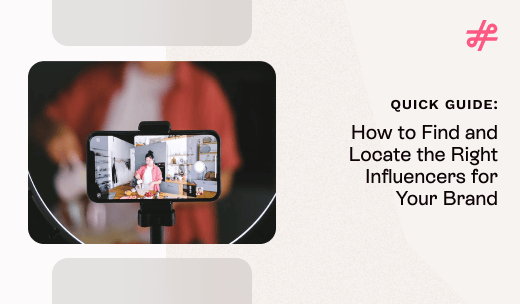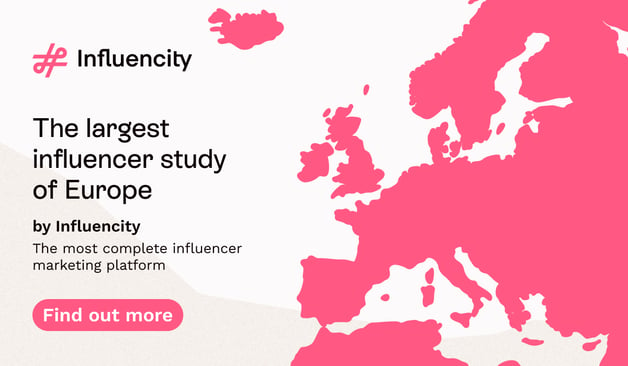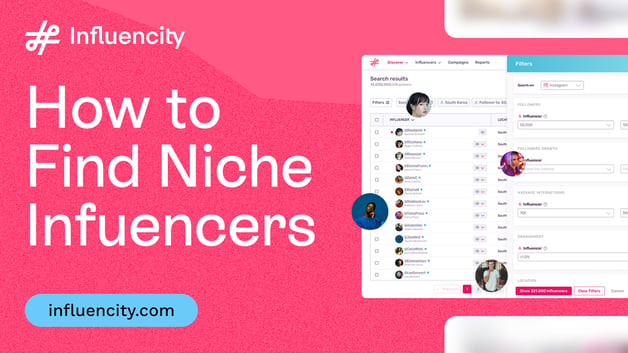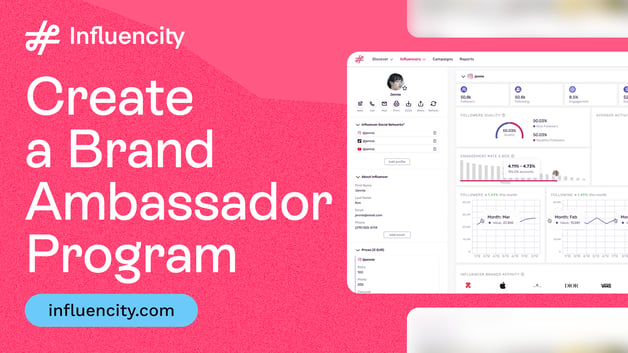How to Track: Social listening tools analyzes conversation data to measure brand sentiment. Influencity’s built-in social listening capability helps you keep a close eye on brand sentiment for specific campaigns.

How to Present Influencer ROI to Clients in a Convincing Way
Besides knowing which metrics to track, successful agency reporting is also about creating compelling reports to establish business value. Below, I share some best practices on how you can convincingly present influencer ROI to clients.
Use Visual Storytelling
Visual elements like charts, graphs, and heatmaps help you break down complex data into bite-sized, digestible information. So it helps clients grasp data more easily, allowing them to seamlessly connect patterns and make accurate comparisons.
For example, displaying a graph that shows how they’ve gained new followers over time is much more effective than simply saying they’ve gained X number of followers. They can use the chart to identify follower growth patterns, especially in connection with their campaign timeline.
Similarly, a chart like the one below helps me visualize just how much more impactful TikTok is than other platforms in driving engagement.

Compare Performance Across Campaigns
Comparison is a great way to show impact. The numbers on a certain campaign may not seem all that impressive until you show that it’s doing far better than a previous campaign. So make performance comparisons between campaigns to highlight the difference that you’re making.
For instance, a 2% engagement rate may not seem very impressive. But considering that the previous campaign only generated a 0.05% engagement rate, that’s an incredible improvement.
If this is your first time running a campaign for the client, you can use their pre-campaign data for comparison. Highlight the improvements in percentages so it’s easier for clients to understand just how impactful your campaigns are.
Provide Benchmarks
On a related note, you’ll also want to show how much better your client is doing compared to others in the same industry. Make sure to include industry standards to serve as a benchmark for comparison. This helps them understand how their campaign compares to those of the competition.
In line with the previous example, a 2% engagement rate may be much more impressive if clients see than the typical engagement rate in their industry is 1%.
Showcase Platform-Specific Influencer Impact
If you’re running a cross-platform campaign, you’ll also want to show platform-wise performance data. This will help clients understand which platforms are driving the highest engagement and conversions. So it’s easier for you to justify your decision to allocate spending to the most impactful platforms to optimize performance.

Tie Influencer Success to Broader Business Goals
To help clients get an even better understanding of the campaign’s value, make sure to align metrics with broader business goals. Your report should connect influencer efforts to goals like revenue growth, lead generation, and customer retention.
This will help them understand the impact of your influencer campaigns on actual business outcomes. And you can give them a reason to keep investing in influencer marketing.
Case Study: How a Top Agency Helped a Cinema Company Generate a £14.70 Return on Ad Spend
When ODEON, a UK-based cinema brand, wanted to grow their TikTok presence, they enlisted the help of The GOAT Agency, a leading influencer marketing agency. Over a 12-month period, the agency strategically planned campaign activations relating to key calendar dates and movie releases.
Since the main goal was to grow the brand’s TikTok presence, they tracked follower growth metrics, growing from 4,000 followers to 100,000 followers by the end of the campaign. They also tracked visibility and engagements to see just how impactful the campaign content was. During the first two quarters, they reported 20 million impressions and a 10.5% average engagement rate.
The agency also tracked bottom funnel metrics to prove the business value of TikTok as a channel for customer acquisition instead of simply driving awareness. They were able to report more than 109k link clicks, resulting in a return on ad spend of £14.70.

Common Reporting Mistakes That Agencies Should Avoid
You may know what metrics to report on and how to draw up compelling reports for your clients. But you could still be making some mistakes that affect the quality of your reporting. Let me share some of the top agency reporting mistakes that you need to avoid.
Focusing Only on Vanity Metrics
Likes and impressions look great on paper. But they don’t equal revenue.
These are all surface-level metrics that measure top-of-the-funnel campaign performance. So if you’re only using vanity metrics in your report, your clients will have a hard time translating them into actual business value.
Dig deeper to showcase how those likes and impressions eventually translate to action and, ultimately, actual revenue. Depending on the campaign goal, you could include metrics like clicks, signups, downloads, and sales, among others. This will help clients understand the business outcome of your campaigns.
Lack of Clear Attribution
There’s no denying that your campaign could drive increased traffic and sales. And you’re probably sharing data about the traffic and sales increase since you launched the campaign.
However, those numbers could also come from somewhere else. For instance, your client’s organic social media marketing and SEO efforts could bring in more traffic. Meanwhile, they may also be driving sales through paid ads and other promotion tactics. So you can’t really prove that those results came directly from your campaign.
That’s why failure to use UTM parameters, discount codes, and affiliate links is a huge mistake. It becomes extremely challenging to prove campaign impact when you’re not clearly attributing traffic and sales to the right sources.
Not Segmenting Influencer Performance
Another major mistake that agencies make in their reporting is only showing the campaign data as a whole. This means they’re not segmenting the data based on individual influencers, campaign, or platform.
So there’s no way of knowing which campaign is performing well, which influencers are driving the best results, and which platforms are the most impactful. Clients are blindly seeing that they’re getting X returns on the campaign, but they don’t have the additional insights to inform future campaigns.
The segmented data could prove to be useful in refining influencer marketing strategies. It could give them a better idea of which platforms to focus on, which influencers to prioritize (and which ones to drop), and how to create more impactful campaigns based on what’s working. But when you’re not segmenting the data, they could keep wasting money on platforms, strategies, and influencer who don’t generate returns.
I recommend investing in a platform like Influencity, which clearly segments all the performance data automatically. In addition to campaign-specific data, you can easily see the performance split between different platforms. You can also track individual influencer performance and get valuable insights to fine-tune your strategies.

Sending Data-Heavy Reports with No Insights
Data is great, and it tells you everything you need to know…if you’re an expert, that is. But for clients, data alone may not be enough to inform their decisions.
Many agencies make the mistake of only sharing numbers and leaving their clients to come up with a conclusion on their own. This leaves too much room for interpretation. And you’re not making it easier for your clients by giving them a job to do.
Your job is to simplify the process of extracting actionable insights from your campaign performance data. So it’s best if you share key takeaways in addition to a more detailed data report. Additionally, include any suggestions that you might have on optimizing campaign performance.
If engagements are high on one platform, what does it mean? Or if certain influencers aren’t driving as many sales as you’d hoped, what do you need to do?
That way, all your clients have to do is act or make decisions based on the insights and suggestions in your report.
The Best Agency Reporting Tools for Influencer ROI
Impactful reporting depends on having access to the right data. And this depends on the tools you use. Here’s a short list of all the tools you really need to improve your agency reporting.
Google Analytics
For campaigns that involve driving traffic to a client’s website, Google Analytics is a must. This lets you track website traffic, along with their referral sources. It even lets you track conversions, also known as “key events” and segments them based on the source. So it’s an essential tool to track traffic and conversions from your influencer campaigns.

UTM Tracking and Link Management
Additionally, you’ll also need a tracking tool to help with UTM tracking and link management for better attribution. This tool should ideally let you create UTM links, manage them, and track their performance in one place.
I love how Rebrandly offers comprehensive management and tracking for your links. You can use the platform to create custom branded links, attach UTM parameters, and track their performance. In addition to the clicks on each link, it further breaks down the performance by unique clicks, best days, and more.

Influencity
For everything else, you have Influencity’s analytics and reporting tool. It gives you comprehensive insights into your campaign performance and even segments data by platform, influencer, and publication. So you can pinpoint your most impactful channels, creators, and content to fine-tune your strategy accordingly.
You get access to some of the most vital metrics like impressions, reach, engagements, engagement rate, and earned media value. You can also keep track of campaign spending and easily calculate campaign ROI.
It even comes with brand monitoring tools, which let you dig deeper into audience sentiment and brand perceptions. What’s more is that you can easily export the data for your client reports.

Taking Your Agency Reporting to the Next Level
Now that I’ve shared a detailed guide on agency reporting, you have all the info you need to create more compelling reports for your clients. Use these tips to prove how your agency helps to generate real business value.
Tags:
Agency Reporting
































%20and%20How%20Can%20They%20Benefit%20Your%20Brand%20article.jpg?length=628&name=What%20Are%20Key%20Opinion%20Leaders%20(KOL)%20and%20How%20Can%20They%20Benefit%20Your%20Brand%20article.jpg)








